Thanks For The Visit !

www.farmboyzimsflightsims.com
FBZFS
Farmboyzim's Fast Flights
Bolivia - It’s Not All Rain Forests!
By Harold “Farmboyzim” Zimmer
Bolivia - It’s Not All Rain Forests!
By Harold “Farmboyzim” Zimmer
We chilled our bones on our last Green Flight in Greenland. Time to warm things up a bit and go south of the equator into Bolivia, located on the continent of South America. It is a landlocked country, sharing its border with five other nations; Peru, Brazil, Paraguay, Argentina, and Chile. The western portion of the country is primarily made up of the mountain range known as the Andes, which runs north/south. This range runs the entire western length of South America, and really offers up a treasure chest of virtual flying possibilities!
Initial impressions of the region left me with the thought that there was little or no “in-between” when it came to the terrain of Bolivia! Mountains that are 20,000 feet plus in elevation and the low lands make up the country of Bolivia. El Alto International Airport outside of La Paz sits at a cozy 13,313 feet! Over a million people inhabit the city of La Paz, so you can see that it’s no small hillside village! Near La Paz is the world’s largest navigable lake, Lake Titicaca. I was amazed at the site of such a huge body of water at such an altitude! I think you will find plenty of room to land a float plane here!
Initial impressions of the region left me with the thought that there was little or no “in-between” when it came to the terrain of Bolivia! Mountains that are 20,000 feet plus in elevation and the low lands make up the country of Bolivia. El Alto International Airport outside of La Paz sits at a cozy 13,313 feet! Over a million people inhabit the city of La Paz, so you can see that it’s no small hillside village! Near La Paz is the world’s largest navigable lake, Lake Titicaca. I was amazed at the site of such a huge body of water at such an altitude! I think you will find plenty of room to land a float plane here!
Sitting on the lake is a place called Copacabana. No, it’s not the nightclub and you won’t find Lola the showgirl there or Rico wearing his diamonds (old song), but you will find an airfield that sits in an area that is bounded by cliffs on three of its sides. FYI, if you select “active runway” when choosing this location, you’ll end up facing the cliff at the other end of the runway!
The area has been compared with Tibet
The Altiplano (high plain), where the Andes are at their widest
“Active Runway” at Copacabana!
This is a lush, verdant country
And so it begins…
Southern portion of Lake Titicaca
Over Copacabana.
Where’s the night club?
Where’s the night club?
El Alto Intl. with military parking in view
to help save their diverse region. I want to point out that when any country has environmental problems, it is not just the problem of that country, it is a problem shared by the entire world. We all share this planet together. Together we can make a huge difference!
That’s a large chunk of real estate! Water pollution from pesticides, fertilizers and mining operations is also an issue in Bolivia. You can see the viscous circle here! One thing inevitably leads to another, especially when it comes to the environment!
agricultural use is certainly a major problem. However, more than 50 percent of Bolivia is still covered by forest. By the way, a little side fact here; Bolivia has more forested land than all of Central America and Mexico put together.
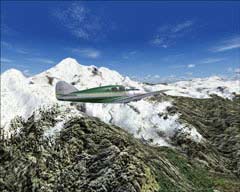
Cities such as Santa Ana, Santa Cruz and Magdalena are situated in the flat, verdant areas, which constitutes about two-thirds of Bolivia. Now, it’s not flat as a pancake, but compared to the Andes, it’s like glass! The area is rich with rivers extending throughout the country, providing the float plane pilot hours of fun! Having the multitude of rivers running like highways can provide a bit more fun for the virtual pilot when flying over flat terrain. I don’t know about you, but I need to load up on the coffee and get 12 hours of sleep if I fly over flat terrain for any length of time!
There’s far too much history and information on the land and culture of Bolivia to present here, so once again, the focus is on the environmental issues of the area, and Bolivia has more than their fair share of problems. The history and culture of this land are well worth looking at however, and can offer up hours of interesting reading. But, in a nutshell…Back in 1532, when the people of the region were still part of the Inca Empire, the first Europeans arrived. For nearly 300 years, the area remained a Spanish Colony. In the year 1825, Simon Bolivar organized the people against the Spanish and ultimately they were victorious.
When most folks think of environmental problems in South America, what usually comes to mind first is the clear cutting of trees. This is only a part of the problem. The practice of the so called “slash and burn” technique of clearing areas of forested land for
There’s far too much history and information on the land and culture of Bolivia to present here, so once again, the focus is on the environmental issues of the area, and Bolivia has more than their fair share of problems. The history and culture of this land are well worth looking at however, and can offer up hours of interesting reading. But, in a nutshell…Back in 1532, when the people of the region were still part of the Inca Empire, the first Europeans arrived. For nearly 300 years, the area remained a Spanish Colony. In the year 1825, Simon Bolivar organized the people against the Spanish and ultimately they were victorious.
When most folks think of environmental problems in South America, what usually comes to mind first is the clear cutting of trees. This is only a part of the problem. The practice of the so called “slash and burn” technique of clearing areas of forested land for
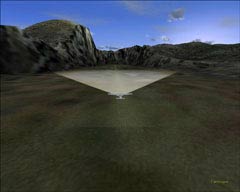
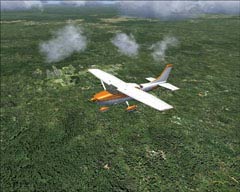
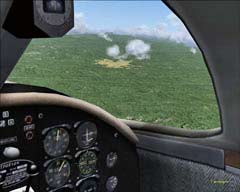
Because of the altitudes that some of the cities are located at, another problem faced by Bolivia is that of the depleting ozone layer. Ozone is found in two places; ground level ozone, which is bad for animals, (I guess that includes us simmers!), having a harmful effect on the respiratory system. This is also known as “Air Pollution”. The other place that ozone can be found at is in the upper troposphere, which is the lowest portion of the Earth’s atmosphere. The ozone layer protects us as humans from an overabundance of ultraviolet radiation, or at least, it used too! We need UV however, for the production of Vitamin D in our systems. A delicate balancing act that has been tipped the wrong way! Folks that live in high altitude areas, such as La Paz and surrounding areas, are having more incidents of skin cancer and eyesight problems than ever before. This is due to the layer of ozone being thin, with the elevation of the population centers not being any help in the matter.
It is worth mentioning that there are things being done to help rectify some of these environmental problems. Amongst them are organizations that actually buy up some of the countries debt in exchange for land being set aside and protected. Often times, encroachment into these areas is difficult to restrict, but at least there is a start in the right direction! It would certainly be worse if no one did anything at all! People in some of the problem areas are being taught better ways of farming and alternate ways of making a living. Not the entire answer, but again, a move in the right direction. There are also many local Bolivian movements
It is worth mentioning that there are things being done to help rectify some of these environmental problems. Amongst them are organizations that actually buy up some of the countries debt in exchange for land being set aside and protected. Often times, encroachment into these areas is difficult to restrict, but at least there is a start in the right direction! It would certainly be worse if no one did anything at all! People in some of the problem areas are being taught better ways of farming and alternate ways of making a living. Not the entire answer, but again, a move in the right direction. There are also many local Bolivian movements
Bolivia is a very poor country, and the people make daily choices based on survival, not just global environmental issues. In some cases this means extending their lands into the forested areas in order to grow more agricultural products, legal and in some instances illegal. The countries protected areas now total more than 16 percent. These protected areas are also the home for some 1.5 million people, 80 percent of whom live in poverty conditions. The areas are also home to hundreds of different species of plants and animals that are threatened with extinction.
The figures were pretty astounding on the amount of land deforested on a yearly basis. Some estimates put the acres clear-cut at 7,700 plus, annually. This is roughly an area the size of New Jersey, to put it into perspective. Numbers such as these are pretty hard to ignore.
Trees do many things other than just look pretty. Not only do they play an important role in the filtration of the air that we breathe, but they also hold the earth in place. Not in orbit, mind you! I’m talking about soil erosion, which is what happens when there are no trees holding things together! This issue is now one of the most important that Bolivia faces. The area gets hit with some pretty wet weather, with daily rainfall totals sometimes totaling in feet not inches. Villages are swept away in mudslides, as well as the valuable topsoil that is necessary for crop growth. Currently, over 30 percent of Bolivia is affected by erosion.
The figures were pretty astounding on the amount of land deforested on a yearly basis. Some estimates put the acres clear-cut at 7,700 plus, annually. This is roughly an area the size of New Jersey, to put it into perspective. Numbers such as these are pretty hard to ignore.
Trees do many things other than just look pretty. Not only do they play an important role in the filtration of the air that we breathe, but they also hold the earth in place. Not in orbit, mind you! I’m talking about soil erosion, which is what happens when there are no trees holding things together! This issue is now one of the most important that Bolivia faces. The area gets hit with some pretty wet weather, with daily rainfall totals sometimes totaling in feet not inches. Villages are swept away in mudslides, as well as the valuable topsoil that is necessary for crop growth. Currently, over 30 percent of Bolivia is affected by erosion.
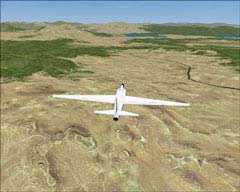
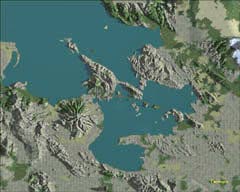
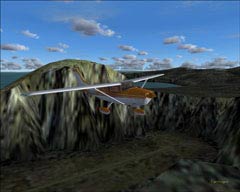
The area has been compared with Tibet
Above the high planes, near La Paz
Dusk over Lake Titicaca
Heading out over Lake Titicaca
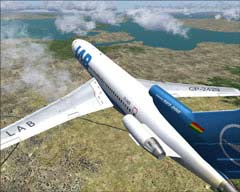
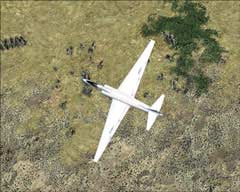
I hope that I have sparked interest in this subject and of the region! I realize that “Save the Rain Forests” is an old slogan, but it is one that is just as pertinent today as when the phrase was first coined. Check out some of these topics on the internet and I think you will be surprised at just how much there is to know about what is going on with the health of our planet. NASA satellite data on the Amazonian Region can be viewed at Science Daily, by following this link…www.sciencedaily.com. Now, on with the subject of simming in steamy South America!
There are not loads of files for the area as far as scenery goes, but there are a few good ones that are worth grabbing up. Some of them can be seen in the screenshots. I used scenery by Oscar Fernando Azcarraga Esquivel for El Alto International Airport, La Paz. Scenery includes high detailed GMax airport with interiors plus hangars, fire fighters, TAM & military platform and emergency runways. Miguel Angel Garnica was the author of the scenery for Jorge Wilsterman (SLCB) Airport, located in Cochabamba, Bolivia. 3D people and a police dog, a manned control tower, the city with "El Cristo de la Concordia" (36 m.), night illuminated and Landclass are included. William Morgan of FRF Studio was the maker of the freeware scenery for Viru Viru International, SLVR, and is a basic rebuild of the airport. Nothing fancy but it is better than the default. There are also AFCAD files available for some of the airports of Bolivia. All of these scenery files definitely added to the pleasure of aviating in the area, but the one you need most is that terrain mesh that I mentioned earlier.
I used a variety of aircraft for this article. Vistaliners Boeing 727-200 in a Lloyd Aereo Boliviano CP-2429 repaint by Rodrigo Flores is a very fine model. Miguel Garnica created the Fokker 27 and come in the LAB and the TAM liveries, both of which are Bolivian airlines. The Airbus A320 by iFDG (excellent freeware developers!) in the TAM livery was also used. Also used for the high altitude shots was the Lockheed U-2R (TR-1A/ER-2) Dragon Lady, by Kazunori Ito. This guy is a one man aircraft factory! One of my favorite aircraft models by Milton Shupe, the Spartan Executive shows its classic lines as well in this article. To round up the list of aircraft is the payware Cessna U206G Stationair 6 from Aerosoft, an excellent model and perfect for the small airstrips that can be found all over Bolivia.
First and foremost, if you do not have any payware mesh products loaded up for the region, grab up the freeware terrain mesh files by Cesar Marinho, boliv_sw.zip, boliv_se.zip, boliv_nw.zip, and boliv_ne.zip. I consider these “must have” files and will really make a huge difference in flying the region of Bolivia, for, as we all know, there are places on the earth that did not get the attention from MS that they deserved. I spotted only a few of those weird “anomalies” that can sometimes be found when mesh is reworked. You may have seen some of them in your wonderings, like the bottomless pits, raised lakes, or spikes rising out of the surface of the earth that would make any punk rocker proud!
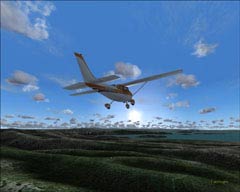
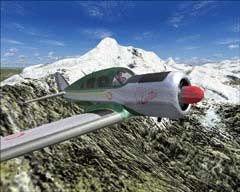








I think I’m in the wrong parking area!
Fokker 27 in LAB colors
Lined up at el Alto, La Paz
Cochabamba Airport
Oh-oh! What have we here?
Very quiet day at Viru Viru Intl.
Lined up and ready to go!
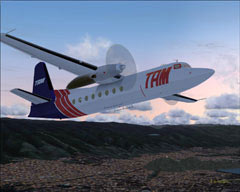
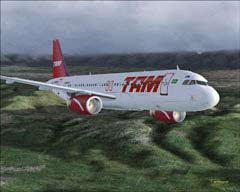
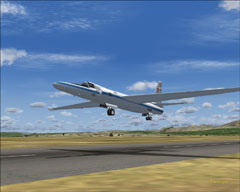
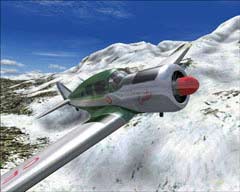
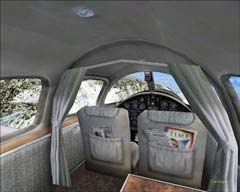
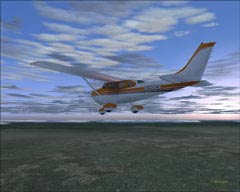
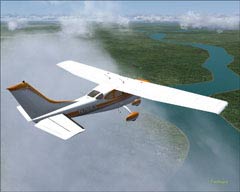
Fokker 27 in TAM colors
Vistaliners A320, TAM Livery
U2 out of Sucre
Shaving some ice!
Excuse me, where’s the pilot???
Sunset on the lowlands
Rivers in the lowlands
The beautiful sky and ground textures can be attributed to Flight 1’s Ground Environment Pro and Flight Environment, which make for some absolutely awesome virtual flying conditions! Thanks gang! Thanks also to all you freeware developers out there, providing us simmers with aircraft and scenery to enhance our virtual worlds! Keep up the great work!
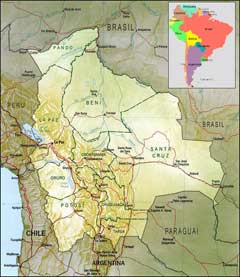
Flying in Bolivia offers the challenges of mountain flying, to the extreme, as well as the challenge of navigating across flat land that does not have many landmarks for VFR flying. This is a region in MSFS that I am sure to return to, as I have not even scratched the surface of areas to explore! I hope you enjoyed this article and I also hope that you came away with an understanding of just how important this area is to the Bolivian people, as well as the world! We are all part of the flight crew on this aircraft called Earth, so let’s keep up on the maintenance! Stay Green! FBZ...\l/










